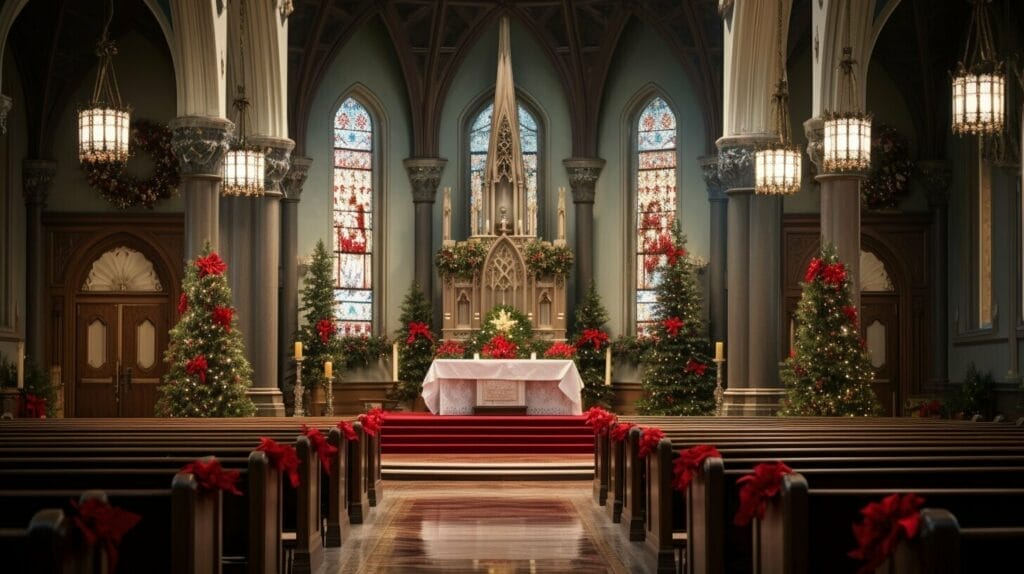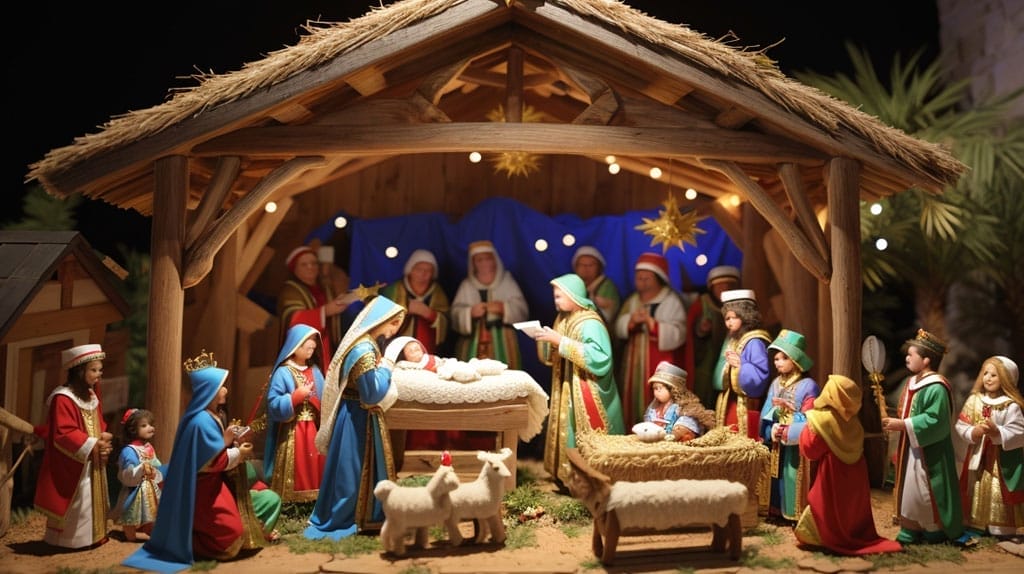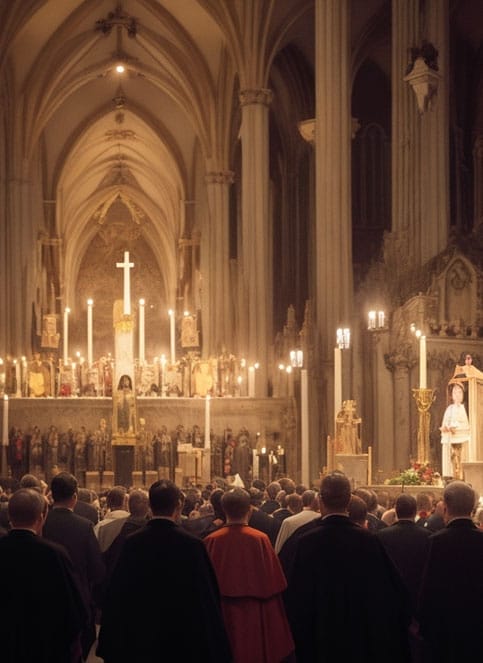The Significance of Catholic Christmas Traditions in Modern Times
Christmas is a time of joy and celebration, steeped in meaningful traditions that have been passed down through generations. As a Catholic, you are part of a rich history that has shaped the way we celebrate Christmas today. Catholic Christmas traditions hold deep significance and provide a spiritual foundation for the holiday season.

We will explore the origins, symbolism, liturgy and rituals, prayers and devotions, and global traditions associated with Catholic Christmas. We will also discuss the challenges and opportunities of maintaining these traditions in the modern world. As we delve into these topics, you will gain a deeper appreciation for the importance of Catholic Christmas traditions in your life and the world around you.
Key Takeaways:
- Catholic Christmas traditions have a rich history and profound significance.
- These traditions encompass customs, liturgy, prayers, and global celebrations.
- Maintaining these traditions in the modern world poses challenges and opportunities.
- Celebrating Catholic Christmas connects us with our faith and the joy of the holiday season.
The Origins of Catholic Christmas Traditions
When it comes to Catholic Christmas celebrations, customs and traditions are an integral part of the holiday spirit. Central to these traditions is the nativity scene, which depicts the birth of Jesus Christ in a manger, surrounded by Mary and Joseph, the shepherds, and the wise men.
The origins of these Catholic Christmas customs can be traced back to the early days of Christianity. The first nativity scene is believed to have been created by Saint Francis of Assisi in the 13th century.
The nativity scene quickly became a popular religious Christmas tradition in Catholic communities and soon spread throughout Europe and beyond. Today, millions of Catholics around the world continue to set up a nativity scene in their homes or churches as a way to celebrate the birth of Jesus.
The Symbolism of the Nativity Scene
The nativity scene is much more than just a decoration; it is a powerful symbol of the Catholic faith. The humble setting of the manger reminds us of Jesus’ message of humility and simplicity. The presence of Mary and Joseph reminds us of the importance of family and the value of love and devotion. The shepherds, who were among the first to witness the birth of Jesus, represent the simple and pure-hearted individuals who are closest to God.

The wise men, who traveled from afar to pay homage to the newborn king, are a reminder of the universal nature of Christ’s message of love and redemption. Their gifts of gold, frankincense, and myrrh are symbolic of Jesus’ divine nature, his role as a priest, and his eventual sacrifice on the cross.
In addition to the nativity scene, there are many other Catholic Christmas traditions associated with the celebration of the nativity. These include prayers, hymns, and rituals that have been passed down through generations and have become an integral part of the Catholic holiday season.
Overall, Catholic Christmas traditions are an essential part of the holiday season, celebrating the birth of Jesus with profound meaning and joy. The customs and practices associated with the nativity remind us of the values and principles of the Catholic faith, bringing us closer to God and each other.
The Role of Advent in Catholic Christmas Celebrations
Advent is a significant season in the Catholic Church, marking the beginning of the liturgical year and preparing for the celebration of Christmas. During Advent, the Church reflects on the anticipation of the coming of Jesus Christ and the hope of salvation for all.
Catholic Advent traditions include a variety of practices and rituals that deepen the spiritual experience of the season. One of the main customs of Advent is the Advent wreath, consisting of four candles that are lit each Sunday leading up to Christmas. Each candle symbolizes a different aspect of the season: hope, peace, joy, and love.
Another central aspect of Catholic Christmas liturgy during Advent is the use of special prayers, such as the O Antiphons and the Magnificat, which are recited during evening Vespers. These prayers express the longing for the coming of the Messiah and the hope of salvation.
Advent is also a time for reflection and repentance, as Catholics prepare themselves spiritually for the celebration of Christmas. This is symbolized by the use of the color violet in decorations and vestments during Advent, which represents penitence and reflection.
In summary, Advent plays a crucial role in Catholic Christmas celebrations, helping to deepen the spiritual significance of the season. Through the use of customs, prayers, and rituals, the Church prepares itself for the joyous celebration of the birth of Jesus Christ.
Symbolism in Catholic Christmas Traditions
As you immerse yourself in Catholic Christmas traditions, you may notice familiar symbols that hold deep meaning and significance. These symbols serve to enrich our understanding of the holiness of the season and remind us of the wondrous miracle that is the birth of Jesus Christ.
The Nativity Scene
The Nativity scene, also known as a crèche, is a beloved Catholic Christmas symbol that typically features a manger or stable, the Holy Family, and various animals. This scene represents the humble surroundings in which Christ was born and reminds us of his message of simplicity, love, and compassion.
The Star
Another iconic Catholic symbol of Christmas is the star, which represents the Star of Bethlehem that guided the wise men to the newborn Jesus. This symbol reminds us of the light that Christ brings into the world and the hope and guidance he provides for those who seek him.
The Christmas Tree
The Christmas tree is a beloved Catholic Christmas symbol that represents the everlasting life and hope that Christ brings. Its evergreen branches symbolize the resurrection and its lights represent the light of Christ that shines in the darkness.
The Advent Wreath
The Advent wreath is a Catholic Christmas symbol that represents the four weeks leading up to Christmas. It typically features four candles, one lit each week leading up to Christmas, symbolizing hope, peace, love, and joy. This symbol reminds us of the anticipation and preparation for the birth of Christ during the Advent season.
As you reflect on the profound symbolism of these and other Catholic Christmas traditions, may they deepen your appreciation for the joy and significance of this holy season.
Catholic Christmas Liturgy and Rituals
When it comes to Catholic Christmas traditions, liturgical elements and rituals hold significant meaning and importance. The celebration of Christmas in the Catholic Church involves a series of liturgies and ceremonies that enhance the joy and anticipation of the holiday season.

The Catholic Christmas liturgy includes the Mass at midnight, the Mass at dawn, and the Mass during the day, each with its unique biblical readings and prayers. The liturgy also incorporates the singing of carols and hymns, including the famous “O Come, All Ye Faithful” and “Silent Night.”
Other integral parts of Catholic Christmas celebrations are the sacraments of confession and communion, which allow individuals to purify themselves and receive Jesus Christ more fully into their hearts.
The rituals associated with Catholic Christmas traditions are equally significant. These include lighting the Advent wreath, setting up the Nativity scene, and blessing the Christmas tree. The Advent wreath with its candles symbolizes the anticipation of Christ’s birth, while the Nativity scene reminds us of the humble circumstances of Christ’s arrival. The Christmas tree, on the other hand, is a more recent tradition that serves to remind us of the everlasting life offered through Christ.
Throughout the liturgy and rituals, the focus remains on celebrating the birth of Jesus Christ and welcoming Him into our hearts and homes. By participating in these practices, Catholics reaffirm their faith and deepen their connection with God.
Celebrating the Twelve Days of Christmas in the Catholic Tradition
For Catholics, the celebration of Christmas does not end on December 25. Instead, the twelve days of Christmas hold special significance, representing the time between the birth of Jesus and the arrival of the Magi. This extended celebration emphasizes the joy and significance of the holiday season.
During this time, many Catholics continue to attend daily Mass and participate in other special liturgical celebrations. They may also continue to display their Nativity scenes and other Christmas decorations. Some may even exchange small gifts or perform acts of charity each day of the twelve-day period.
The culmination of this extended celebration is the Feast of the Epiphany on January 6, which commemorates the Magi’s visit to the young Jesus. In some cultures, this day is marked by special processions and other festivities.
By celebrating the twelve days of Christmas, Catholics can further reflect on the profound significance of the Incarnation and the role of Jesus in their lives. It also provides an opportunity to extend the joy and spirit of the holiday season and share it with others.
Catholic Christmas Prayers and Devotions
As a Catholic, you know that prayers and devotions are an important part of the faith, especially during Christmas. These prayers are a way to connect with God, reflect on the true meaning of the holiday, and express gratitude for all blessings. Here are some Catholic Christmas prayers that you may find helpful during this season:
“Hail and blessed be the hour and moment in which the Son of God was born of the most pure Virgin Mary, at midnight, in Bethlehem, in the piercing cold. In that hour, vouchsafe, O my God! to hear my prayer and grant my desires, through the merits of our Savior Jesus Christ, and of His Blessed Mother.”
– The Christmas Novena Prayer
The Christmas Novena Prayer is a beautiful way to honor the birth of Jesus over a nine-day period leading up to Christmas. It is a powerful prayer that asks for God’s mercy and guidance in our lives.
Another popular prayer is the Angelus, recited three times a day (6:00 am, noon, and 6:00 pm) during Advent and Christmas. It recalls the message of the angel Gabriel to Mary and invites us to join in her joy and obedience to God.
“Hail Mary, full of grace, the Lord is with thee. Blessed art thou among women, and blessed is the fruit of thy womb, Jesus. Holy Mary, Mother of God, pray for us sinners, now and at the hour of our death. Amen.”
– The Hail Mary
The Hail Mary is a fundamental prayer of the Catholic faith, recited daily by millions around the world. It is a beautiful tribute to Mary, the Mother of Jesus, and a reminder of her intercessory role as we seek salvation and healing from God.
During Christmas Mass, you may also encounter the Litany of Loreto, a prayer that lists the many titles of our Lady. It is a powerful invocation of Mary’s protection, guidance, and love for us.
These Catholic Christmas prayers and devotions are just a few examples of the rich spiritual heritage of the faith. As you celebrate the birth of Jesus Christ this Christmas, take time to pray, reflect, and give thanks for the blessings in your life.
Catholic Christmas Traditions Around the World

Catholic Christmas traditions vary from country to country, reflecting the unique cultural expressions of faith. In Spain, it is customary to celebrate with a procession called “La Cabalgata” on January 5th, where the Three Wise Men ride through the streets and hand out presents to children.
In Poland, Christmas Eve is the main celebration, and families gather to share a meal and exchange gifts. In the Philippines, “Simbang Gabi” is a nine-day series of early morning Masses leading up to Christmas.
In Italy, it is traditional to celebrate with a huge feast called “La Vigilia,” which consists of seven fish dishes. In Mexico, the celebration of “Las Posadas” reenacts Mary and Joseph’s search for a place to stay, with processions and singing. In Germany, “Christkindlmarkt” is a favorite tradition, where people gather at festive markets to shop for Christmas treats and gifts.
These are only a few examples of the rich Catholic Christmas traditions found around the world. Each one reflects the unique history, culture, and faith of the people who celebrate them.
Keeping Catholic Christmas Traditions Alive in the Modern World
In today’s fast-paced and ever-changing world, it can be challenging to maintain the traditions and customs that have been passed down through generations. However, Catholic Christmas traditions hold deep meaning and should continue to shape our celebrations today and in the future. Here are some ways you can keep these traditions alive:
- Attend Mass regularly: One of the most significant Catholic Christmas traditions is attending Mass on Christmas Day. By participating in Mass, you not only connect with the religious significance of the holiday but also join a community of believers who share your values and beliefs.
- Create a Nativity scene: Setting up a Nativity scene in your home can be a powerful reminder of the true meaning of Christmas. By including elements such as the manger, Mary, Joseph, and the baby Jesus, you can visually represent the story of Christ’s birth and reflect on its significance.
- Share the joy of Christmas: The Catholic Christmas spirit is all about spreading joy and goodwill to others. Look for opportunities to volunteer, donate, or simply spread kindness in your community. You can also invite friends and family to join in your Christmas celebrations and share the traditions that are important to you.
- Explore your cultural heritage: Catholic Christmas traditions are observed around the world, and there are numerous customs and practices that reflect diverse cultural heritage. Take the time to learn about your family’s cultural background and how these traditions can be incorporated into your celebrations.
- Adapt to modern times: While it’s important to preserve the essence of Catholic Christmas traditions, it’s also necessary to adapt them to modern times. For example, you can use social media to connect with other Catholics and share your experiences and insights. You can also incorporate modern technology into your celebrations, such as using a digital Advent calendar.
By keeping Catholic Christmas traditions alive, you can connect with the rich history of the faith and celebrate the birth of Jesus Christ in a profound and joyous way. Embrace the traditions that are meaningful to you and find new ways to incorporate them into your life, both now and in the future.
Preserving Catholic Christmas Traditions
While the modern world presents challenges to maintaining traditions, it also presents opportunities to adapt and innovate. Consider how you can preserve Catholic Christmas traditions in your family, community, or church.
You could incorporate new practices or find ways to involve younger generations in the celebration. You could also reach out to other Catholic communities and learn about their unique traditions. By keeping these traditions alive, you contribute to the tapestry of Catholic culture and strengthen the bond between faith and family.
As you celebrate this joyful season, remember the true meaning of Christmas and the significance of these traditions. May this holiday season bring you peace, love, and blessings.
FAQ
Q: What are some common Catholic Christmas traditions?
A: Some common Catholic Christmas traditions include attending Mass on Christmas Eve or Christmas Day, setting up a Nativity scene, lighting Advent candles, and participating in the sacraments.
Q: Why are Catholic Christmas traditions significant?
A: Catholic Christmas traditions hold deep religious and cultural significance. They help believers connect with the story of Jesus’ birth, express faith and gratitude, and foster a sense of community and joy during the holiday season.
Q: How did Catholic Christmas traditions originate?
A: Catholic Christmas traditions originated from a combination of biblical accounts of Jesus’ birth, early Christian practices, and cultural customs dating back centuries. They have evolved and been passed down through generations.
Q: What is the role of Advent in Catholic Christmas celebrations?
A: Advent is a period of preparation and anticipation leading up to Christmas. In Catholic Christmas celebrations, Advent is marked by special prayers, lighting of Advent candles, and reflection on the coming of Jesus Christ.
Q: What are some symbolic elements in Catholic Christmas traditions?
A: Catholic Christmas traditions are rich in symbolism. The Nativity scene represents the birth of Jesus, the star symbolizes the guiding light of the Wise Men, and the Christmas tree is a symbol of eternal life. These symbols reflect the central themes of the holiday.
Q: What are some liturgical aspects of Catholic Christmas traditions?
A: Catholic Christmas traditions involve liturgical elements such as the Christmas Mass, special prayers, hymns, and rituals. These aspects enhance the worship experience and convey the joy and reverence of the season.
Q: How do Catholics celebrate the twelve days of Christmas?
A: Catholics celebrate the twelve days of Christmas by extending the festive period beyond Christmas Day. Each day is dedicated to a specific theme or saint, and it is a time for continued celebration, reflection, and devotion.
Q: What are some popular Catholic Christmas prayers?
A: Popular Catholic Christmas prayers include the Hail Mary, the Angelus, and the Litany of Loreto. These prayers are often recited during the Christmas season as a way to seek Mary’s intercession and honor her role in Jesus’ birth.
Q: How do different countries observe Catholic Christmas traditions?
A: Catholic Christmas traditions vary across different countries. For example, in Mexico, there are processions and reenactments of Mary and Joseph’s journey to Bethlehem. In the Philippines, Simbang Gabi (Night Mass) is a significant tradition. Each country brings its unique customs to the celebration.
Q: How can Catholic Christmas traditions be kept alive in the modern world?
A: Catholic Christmas traditions can be kept alive in the modern world by actively practicing and passing them on to younger generations. Embracing technology to connect with others, participating in church events, and incorporating traditions into family celebrations can help preserve and adapt these customs.




